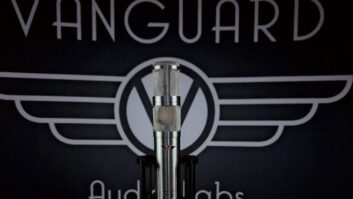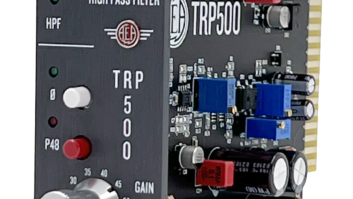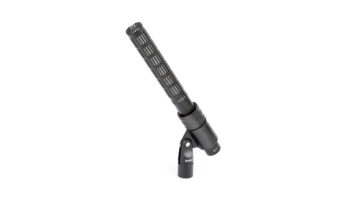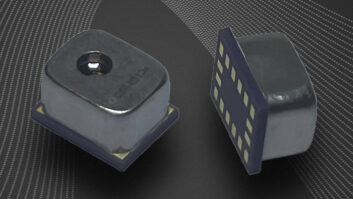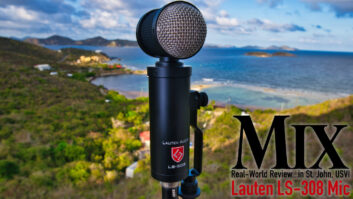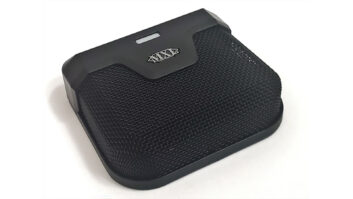
AEA’s slick, retro-looking R84 ($1,000) is the newest mic in
designer Wes Dooley’s product line. Sensitivity of the R84 is -52 dBV/Pa, and unlike its big (and much heavier)
brother, the R44, the R84 exhibits an impressive frequency response
that gets up to 20 kHz (±3 dB). What it does share with the R44 is
a 0.185×2.35 inches by 1.8-micron, pure-aluminum, low-tension ribbon capable of handling better than 165dB SPL
above 1 kHz. The R84 comes in a durable and functional foam-lined case
and includes an integral shock-mount and 10-foot cable that terminates
to an XLR. The mic is a svelte performer that weighs in
at less than two pounds and measures 8 inches tall and 2.7 inches in
diameter. The mic’s weight and compact nature, along with the fact that
the shock-mount allows it to swing freely on two axes, make it a breeze
to set up and tuck into relatively tight spots.
IN THE STUDIO
Right out of the box, the mic is a looker. At first, the heavily padded
zippered “sock” that houses the mic seems a little odd, but
on further inspection, its usefulness becomes apparent. It comes with a
carrying strap, a small pouch and a fastenable loop to keep the cable
in order. The case sports blatant reminders to keep phantom power and dust as far away from the mic as
possible. The mic itself is solid, and its bullet-like styling garnered
“oohs” and “aahs” in the studio. The screw
adjustments for the shock-mount and cable attachment are of high
quality and are sure to stand up to years of use.
I used the mic on a number of acoustic instruments with great
results. First call was on a dobro overdub at 96k using a Pro Tools|HD
system. The song was heavily layered with guitars, mandolin, fiddle and
vocals, and I was wondering where the dobro would fit in the mix. It
was immediately clear that the R84 would make my job easier. The dobro
cut through the mix without EQ and sounded, for lack of a more
appropriate word, perfect.
Next, I tried the mic on a Martin acoustic guitar. This particular
guitar is fitted with the Buzz Feiten tuning system and sounds
fantastic. The R84 captured the Martin beautifully, rounding out the
transients and presenting a balanced track that only needed a bit of
the low end tucked in.
The most revealing test for the mic was when I used it to record a
less-than-inspiring 6-foot grand piano. I was concerned about using the
instrument because it was going to support a lead vocal with only a
synth pad as a companion. The instrument was tuned just before the
session, and I placed the R84 right at the middle of the soundboard,
pointing straight down at the hammers. The R84 offered the perfect
combination of frequency and transient response to tone down the
inconsistencies in the piano, producing a track that was more than
usable.
Next, I had the R84 at moderately close quarters with a guitar amp
at blazing levels. It was shut in a small bathroom about two feet back
from the twin 12-inch speaker cabinet. I guessed on the best position
and then threw my hands up when I got back to the console. It sounded
wonderful.
I thought the mic sounded so good on-axis that I never tried
recording using the back end of the mic, but after talking to Wes
Dooley, I will certainly do so at the next opportunity. Dooley revealed
that the internal screen is doubled up on the off-axis side of the mic.
Because of this, the rear of the mic exhibits its own particular
personality. In addition, this protection would also be a
“safer” way to use the mic for more plosive, ribbon-killing
situations like vocals.
CONCLUSION
I’m always wary of market-speak that surrounds a product of any kind,
audio or otherwise. But when AEA states that the R84 produces “a
pure, natural sound, just as you hear it when you’re placing your mic
in the studio,” the company is absolutely right. The one caveat
is true of all ribbons: Make sure your preamp is the correct recording
companion. You’ll need plenty of clean gain, especially if you’re using
the mic on quiet acoustic instruments.
At this price, you should have at least one R84 in your locker,
especially if you’re looking to put some life into your digital signal
chain. When using even high-quality condensers with a DAW, you forget how good things
can sound and end up settling for “really good” instead of
“excellent.” A quality ribbon like the R84 can take a
production to the next level, injecting some butter into a margarine
world.
AEA Microphones, www.wesdooley.com


